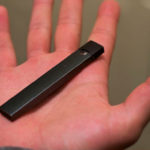 June 6, 2019
June 6, 2019
 Asthma, Breathe EZ, Children's Health
Asthma, Breathe EZ, Children's Health
 Leave a comment
Leave a comment
 asthma, Asthma Triggers, e-cigarettes, Florida Youth Tobacco Survey, vaping
asthma, Asthma Triggers, e-cigarettes, Florida Youth Tobacco Survey, vaping
It is hard to imagine that many people still believe that the vapor produced by e-cigarettes is harmless. They believe that the sweet smelling cloud produced by someone vaping nearby is just water vapor. The secondhand vapor from e-cigarettes actually contains many of the same chemicals that are found in traditional ones. These contaminants include propylene glycol, vegetable glycerin, nicotine and many different flavoring agents.
 No one should be inhaling any of these toxic substances because they will all cause inflammation in your lungs. Asthma sufferers and those with allergies are especially at risk of exposure to lung irritants. Studies by the National Academies of Science indicate that e-cigarette use increases asthma symptoms such as coughing and wheezing.
No one should be inhaling any of these toxic substances because they will all cause inflammation in your lungs. Asthma sufferers and those with allergies are especially at risk of exposure to lung irritants. Studies by the National Academies of Science indicate that e-cigarette use increases asthma symptoms such as coughing and wheezing.
The good news is that e-cigarettes are different from traditional cigarettes in one way, they only emit vapor when they are being used.
New Research Based on the Florida Youth Tobacco Survey
The Florida Youth Tobacco Survey data (link to data) was the basis for some recent research to determine the connection between electronic nicotine delivery systems (ENDS) and asthma symptoms. The survey data indicates that e-cigarette use was up almost 600% from 2012 to 2018 in youth ages 11-17. The rate of youth trying e-cigarettes is also up over 350% in the same date range.
Survey Data Demographics:
- Study based on surveys from almost 50,000 youth and teens.
- 33,500 respondents were in High School and another 36,000 were in Middle School.
- Respondents were evenly split by gender.
- One-third identified as Hispanic, one-third are white, and one-fifth as African American.
- About 75% of survey participants lived in large or mid-sized metro areas.
- The research focused on the 11,000 respondents diagnosed with asthma.
Study Definition of Exposure to secondhand vaping aerosol: Exposure to someone vaping either in the same room or in a car within the last month.
Tips for Parents
 The statistics on the rates of vaping are staggering. In 2018 the CDC reported that 20% of high school students vaped in the past 30 days. Smoking rates in the same age group are actually lower at only 8 percent. The rate of teen smoking continues to fall; it is 50% lower than it was in 2011.
The statistics on the rates of vaping are staggering. In 2018 the CDC reported that 20% of high school students vaped in the past 30 days. Smoking rates in the same age group are actually lower at only 8 percent. The rate of teen smoking continues to fall; it is 50% lower than it was in 2011.
The national rate of smoking in adults is 14% (2017), down from 20% in 2005. In contrast only 2.8% of adults use e-cigarettes.
Nicotine is toxic to children, even at minimal exposure levels. Their developing bodies are even more susceptible to environmental pollutants like nicotine and the other dangerous components of e-cigarette vapor.
- Encourage your children to avoid secondhand vaping aerosols just like secondhand smoke from traditional cigarettes.
- Educate family members and friends who vape to do so away from children and especially not in enclosed spaces.
- Communicate with your children about the dangers of smoking and vaping so they know the risks.
If your child has asthma, consider adding limiting exposure to vaping in your child’s asthma action plan – due to the possibility of it triggering an asthma attack.
Additional Resources
- Secondhand Exposure to Aerosols From Electronic Nicotine Delivery Systems and Asthma Exacerbations Among Youth With Asthma
- Florida Youth Tobacco Survey – View data by county, survey questions, previous results
- Vaping Infographic
- E-Cigarettes – Continued Health Threat for Youth
- Vaping is Smoking Too
















